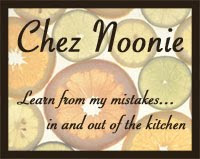Despite this, he married me and we began to create our own traditions for Passover. We found a Hagaddah that worked for us and teamed up to get everything ready. Generally, I cook, and he cleans - this works for us on most occasions. One year I decided to chuck the jars and make my own gefilte fish. I ordered the fish, picked it up, brought it home, and feeling like the little red hen began to cook. Except I forgot to ask them to grind it...but no worries, I had received a food processor as a wedding gift. How hard could it be.
Lesson learned, chopping fish is not easy. Whether you do it the old fashioned way (with multiple cleavers and all your friends and relatives in a small apartment kitchen in Brooklyn) or with a La Machine, it is messy, time consuming, and downright ugly. First, I chopped the fish into 2 inch squares and added them to the machine. After about five seconds of the most terrifying noise ever heard, it started to smell like it was burning. I grabbed the plug, dumped it all out, and started again. In the end, it took me over 2 hours to grind that fish at home, and two minutes to realize that I would never do it again. My husband wisely stayed out of the kitchen.
I let the mixture sit overnight as directed, giving myself some time to cool down and my husband an opportunity to clean up the ground fish that found its way into every corner of our kitchen. I am telling you, this man is a miracle - he actually got it all up - left to my own devices I would have just called Terminix. The next day was a new day, and as I put two large stockpots up to boil, I was feeling more confident. Until the stock. Now, I had asked for the heads and bones per the recipe, but was not prepared to actually handle them. So creepy looking and sharp to the touch, I could not believe I was going to use this as food. To calm myself, I sang the fish head song (you know it..fish heads, fish heads, roly poly fish heads. Fish heads, fish heads, eat them up, yum.). That seemed to do the trick, as I triumphantly added the fish to the pots.
Later on, my husband went to to clean up, he was pleasantly surprised to see me calm, with 20 or so delicious gefiltes waiting to be eaten. He went to clean the stockpots and let out a little scream, not expecting the fish carcasses to cascade down into the sink, bobbing about like little sea demons. I bet he missed the jarred kind that year.
Anyway, we have now gotten into a better routine. I know to get the fish ground at the fish monger, he knows what to expect in the pot. Both of us really enjoy the results, and our guests are always surprised and grateful to have this relatively simple dish, if you know the tricks. Enjoy and happy Passover.
Gefilte Fish
From The Second Avenue Deli Cookbook
IngredientsFor the gefilte fish balls
- 1 (1 1/2-pound) fillet of whitefish and (1 1/2-pound) fillet of carp or pike (at fish store, ask for whole fish, filleted and skinned. Retain the heads and bones. Many stores will also grind the fish for you)
- 2 large onions (about 2 cups when grated; don't tamp it down)
- 1 stalk celery
- 1/2 medium carrot
- 6 eggs, beaten
- 4 teaspoons sugar
- 2 1/2 teaspoons salt
- 3/8 teaspoon pepper
- 3/4 cup corn oil
- 1 cup matzo meal
For the cooking
- Heads and bones from fish
- 4 medium onions, peeled and quartered
- 2 stalks celery, trimmed and chopped into 3-inch pieces
- 2 medium carrots, peeled
Method
- In a food processor or grinder, grind fish (refrigerate heads and bones for later use), 2 onions, 1 stalk celery, and half a carrot. (If you use a food processor, make sure you leave no large pieces of fish or bones; you may want to transfer the mixture, bit by bit, into a wooden bowl, and go over it vigorously with a hand chopper.)
- Place fish mixture in a large bowl, and add eggs, sugar, salt, pepper, and corn oil, mixing thoroughly with a wire whisk. Stir in matzo meal, and continue to mix until everything is thoroughly blended. Refrigerate for 1 hour or more (longer, even overnight, is better).
- Fill 2 large stockpots three-quarters full of water, and bring to a vigorous boil. In each, throw in half the fish heads and bones, 2 onions, half the celery, and a carrot. Divide batter into 12 patties of equal size. (Don't worry that your batter is a little loose; it has to be that way to keep your gefilte fish light.) Transfer each patty to a large cooking spoon, shape into an oval, and very gently lower it into the boiling water. Put 6 in each pot. Lower heat and simmer for 1 1/2 hours.
- Remove fish balls and carrots from pots, and refrigerate on a covered plate. Discard everything else. Serve chilled with red and/or white horseradish. Slice carrots for garnish.





